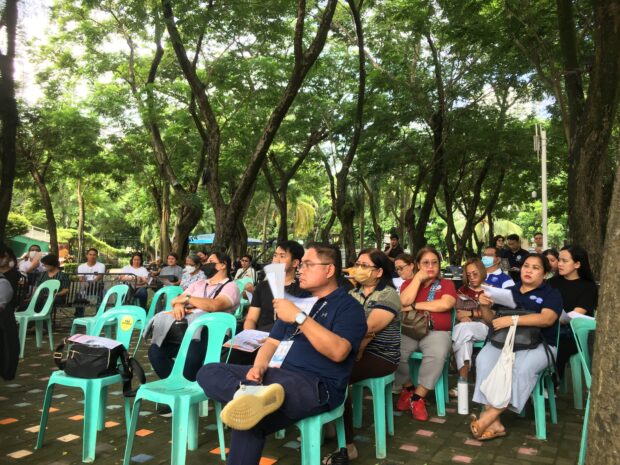Environment group proposes tapping disasters as resource

The environment group IDIS held the forum, “Turning down the heat,” under the canopy of trees at the Davao City People’s Park. GERMELINA LACORTE
DAVAO CITY — Now that people are starting to bear the brunt and discomforts of abnormal weather, an environmental group in this city is asking why not tap this kind of disaster as a resource?
This was what the Interfacing Development Interventions for Sustainability (IDIS) proposed as it released the results of its study on the effects of urban heat islands (UHI) on the city’s green spaces.
The study defined “heat islands” as urbanized areas with higher temperatures, compared to outlying areas, because of the high concentration of buildings, roads, infrastructure, and limited greenery.
Areas with more buildings and pavements proved to be the hottest and most uncomfortable for people as compared to places with more trees and vegetation, the study showed.
More parks, trees
IDIS urged policymakers to advocate the building of more parks and waiting sheds, the use of porous and permeable materials in the building of roads and pavements and to incorporate trees and vegetation in urban landscapes to reduce the discomfort of commuters, pedestrians, and the greater public.
But also among its recommendations in dealing with the rising temperature and the increasing frequency of flooding is for policy-makers to treat these disasters–from the extreme heat of the El Niño to the excess water during the La Niña–as a resource that could benefit the public.
Solar power
Lemuel Manalo, IDIS program coordinator and environment planner, said the heat from the sun could be tapped as a solar energy to power the city’s households and reduce the city’s dependence on environmentally harmful fossil fuel; while excess rainwater during La Niña could be harvested on the city’s rooftops to prevent flooding.
The group’s call came as the state weather bureau said abnormal sea surface temperature had been detected in the Central and Eastern Equatorial Pacific, which could mean the start of El Niño.
Lolita Vinalay, chief meteorological officer of the Philippine Atmospheric, Geophysical and Astronomical Services Administration (Pagasa), explained that Davao region was still experiencing lots of rains since it would take time for the impact of the warming of that part of the Pacific to reach the country.
Vinalay, however, said Pagasa would release an updated El Niño advisory on July 2.
‘Heat islands’
The IDIS study, which covered 12 months and ended in April this year, compared the “heat island” effects, by monitoring among others, the ambient temperature and humidity in at least six public parks and open spaces in the city; namely: Clifford Park, the Marfori Botanical Garden Park and the C.M. Recto street of Poblacion district; Dacudao Avenue of Agdao district and the Matina Linear Park of Talomo district.

Citizen science volunteers, mostly students, monitor the ambient temperatures of pavements and open spaces at the Matina Linear Park in Davao City, part of the one-year study on the city’s Urban Heat Islands (UHI) conducted by the environment group IDIS. CONTRIBUTED PHOTOS BY IDIS
Hard-built surfaces such as cemented roads and infrastructure consistently posted high temperature levels compared to porous surfaces and permeable bricks, the study results showed.
“Among the hottest are the waiting areas of Roxas Avenue and Aldevinco,” Manalo told the Inquirer.
“These are loading and unloading areas of passengers but in the course of the study, the area posted the highest temperature of 45 degree Celsius, which is already a dangerous level,” he said, referring to the days between February and April this year, when the city’s heat index registered among the highest in the country.
Cooler temperatures were noted under the tree canopies, particularly under the shade of bamboo clumps at Marfori’s Botanical Park, which proved to be the coolest for the entire length of the study.

Citizen science volunteers, mostly students, monitor the ambient temperatures of pavements and open spaces at the Matina Linear Park in Davao City.
Even at the Matina Linear Park, considered the hottest among the green spaces in this city because of its few full-grown trees, the shade of the park’s Talisay tree also registered a cool respite from the heat, he said.
Justin Joshua Pungyan, IDIS environment research officer, who presented the study, noted that temperature among hard-built surfaces such as cemented roads, concrete benches with metal railings, had peaked to as high as 45 degrees Celsius between February and April when the city registered a high heat index; but permeable paved spaces such as the brick-layered walkways only went as high as 43 degrees Celsius.
Open landscaped spaces registered the highest temperature of 44 degrees Celsius between May and July 2022, but the spaces under the trees, only went as high as 35 degrees Celsius.
Lawyer Mark Peñalver, IDIS executive director, said they presented the study results under the canopy of trees at People’s Park here to show how uncomfortable the increasing heat in the city had become and to stress the need to build a greener urban environment.
The higher the temperature goes, the higher the discomfort level noted by the people using these spaces, he said.
Need to prepare
Vinalay stressed the need to prepare for the onset of the El Niño, projected to be moderate to strong when it hits the country later this year.
She said the region in the Pacific which had a direct effect on the Philippines already registered a sea surface temperature anomaly of 0.9 degree Celsius, higher than the 0.5 degree Celsius, which indicates an El Niño. She said the team of scientists monitoring it were still trying to see if the trend would remain consistent in three months.
She said the public could prepare by conserving water and other resources, turning down appliances, especially air conditioning systems, when not in use.
RELATED STORIES
Scientists warned of global warming, but ‘we didn’t … – Inquirer.net
Humanity: Biggest obstacle to climate change | Inquirer Opinion
Pagasa: El Niño may bring drought to Camarines Norte … – Inquirer.net